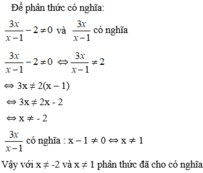
Hãy nhập câu hỏi của bạn vào đây, nếu là tài khoản VIP, bạn sẽ được ưu tiên trả lời.


a: ĐKXĐ: \(x\notin\left\{0;1\right\}\)
b: ĐKXĐ: \(x\notin\left\{2;-2\right\}\)
\(a,ĐK:x\ne0;x-1\ne0\Leftrightarrow x\ne0;x\ne1\\ b,ĐK:x^2-4=\left(x-2\right)\left(x+2\right)\ne0\Leftrightarrow x\ne2;x\ne-2\)

a) ĐK: \(x-5\ne0\Leftrightarrow x\ne5\)
b)
ĐK: \(\left(\dfrac{1}{2}x+4\right)\ne0\Leftrightarrow\dfrac{1}{2}x\ne-4\\ \Leftrightarrow x\ne-8\)
c)ĐK:
\(-2x-10\ne0\\ \Leftrightarrow-2x\ne10\\ \Leftrightarrow x\ne-5\)
a) ĐKXĐ: \(x\ne5\)
b) ĐKXĐ: \(x\ne-8\)
c) ĐKXĐ: \(x\ne-5\)

\(\dfrac{x}{4+2a}\) có nghĩa khi \(a\ne-2\)
\(\dfrac{y}{4-2a}\)có nghĩa khi \(a\ne2\)
\(\dfrac{z}{4-a^2}\)có nghĩa khi \(a\ne\pm2\)
MTC: \(2\left(2+a\right)\left(2-a\right)\)

Để phân thức có nghĩa:
x 2 + 5 x + 4 ≠ 0
⇔ (x + 4)(x + 1) ≠ 0
⇔ x ≠ -4, x ≠ -1
Vậy điều kiện để phân thức xác định là x ≠ -4 và x ≠ -1

Để phân thức xác định ta có:  có nghĩa:
có nghĩa:

Vậy với x ≠ -3 và x ≠ ½ thì phân thức đã cho được xác định

Để \(A\)có nghĩa thì \(x^3-3x-2\ne0\)
\(\Rightarrow\left(x^3-x\right)-\left(2x-2\right)\ne0\)
\(\Rightarrow x\left(x^2-1\right)-2\left(x-1\right)\ne0\)
\(x\left(x+1\right)\left(x-1\right)-2\left(x-1\right)\ne0\)
\(\left(x^2+x-2\right)\left(x-1\right)\ne0\)
\(\Rightarrow\left[x^2-1+x-1\right]\left(x-1\right)\ne0\)
\(\left[\left(x-1\right)\left(x+1\right)+\left(x-1\right)\right]\left(x-1\right)\ne0\)
\(\left(x-1\right)^2\left(x+2\right)\ne0\)
\(\Rightarrow x\ne1;-2\)
Vậy...

Để phân thức có nghĩa: x – 1 ≠ 0 ⇔ x ≠ 1